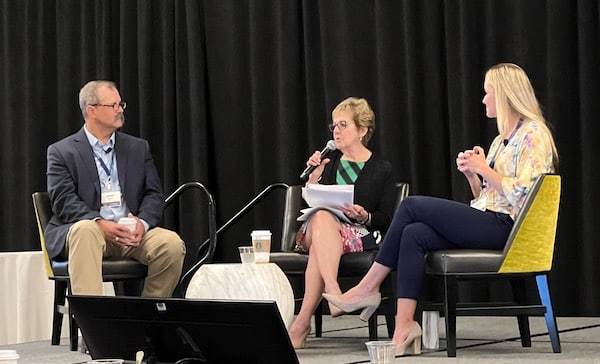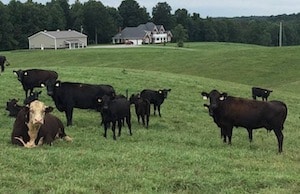
What we choose to eat does impact the environment and our social surroundings. But setting parameters without context can inhibit our ultimate goal of good food for all. It’s not a “yes or no” question of plant or animal, but rather a “yes, and.”
The Basics of Eating Sustainably
Whether we fall into the “eat to live” or live to eat” category, the bottom line is that food is essential regardless of its source. However, when put in the context of our own lifestyle, the parameters often change to what we individually perceive as eating sustainably. In the recently released 2023 IFIC Food and Health Survey, a third of U.S. consumers state that environmental sustainability is highly impactful on their decisions to buy foods and beverages, yet this ranking falls significantly below the more important factors of taste, price, convenience and healthfulness. Despite the academic definition of sustainable diets being “accessible, available, nutrient-dense, and culturally appropriate”,1 it still hard to define. Here lies the issue.
Food is Not a Simple Subject
Acknowledging the complexity of the issue, here are some key themes shared during our panel discussion:
- Food systems are complex. The natural land and agricultural systems that support the growing of food are extraordinarily complex. The often-heard question of “why don’t you replace land used for grazing beef or dairy cows with growing vegetables?“ is a perfect example. Land use, climate and soil health are complex issues that even those involved in daily ranching and farming find perplexing. For example, beef cattle can graze on lands that could NEVER be used for growing produce.
- The facts behind simple food production statements are complicated. Whether it’s facts about land use, greenhouse gas emissions, or carbon footprints, it is important to have context when we see or hear big numbers. As mentioned previously, land use is a good example. As Jason mentioned during the discussion, the total number of acres “used” to support animal production systems seems enormous, but use does not eliminate other benefits derived from that land. Much of the land used for grazing food-producing animals is an example of upcycling an abundant renewable resource (land) into high quality food and fiber, while also supporting wildlife, clean air and water. We also should keep in mind that “use” is not singular.
Put numbers into context. The greenhouse gas emissions numbers from agriculture seem large until they are placed in the context of emissions from all sources and production systems. There is often a “bull’s eye” on beef production regarding its carbon footprint when it’s defined by global numbers. For example, U.S. production of beef accounts for less than 4% of total greenhouse gas emissions rather than the global percentage of approximately 14%, which is frequently cited.
- Food is our body’s fuel. As Lauren emphasized during our discussion, food must meet the nutritional needs of today’s population and future populations if it’s truly sustainable. It’s about the end game of being nutritionally fed … and promoting the balance of plants and animals. For example, beef is a naturally occurring excellent source of protein, vitamins (Vitamins B12, B6, niacin) and minerals (zinc, selenium, phosphorous). Animal food sources provide us nutrients that plants do not, and fruits and vegetables provide essential vitamins and minerals that are not found in animal sources. It’s a balancing act.
- Be aware of unintended consequences. Sometimes, what we say or do can create more food divide and fear. What may seem like well-intended advice or action without putting the complexity of the food system into context, can move us further from our goal of achieving a sustainable food system. We must think about what the tradeoffs are when we make food decisions locally and globally. Will our actions today create the desired food system for tomorrow’s population?
Bottom Line

NOTE: The insights of Jason Sawyer and Lauren Twigge contributed significantly to the content of this blog. While the Today’s Dietitian Panel was sponsored by the Beef Checkoff, the opinions expressed in this blog are my own and made without compensation.
Footnote:
1. Smith Edge, M. “The Balancing Act-Nutrition and Sustainability,” Nutr Today. 2020;55(2):86–92.
Resources:
- “Food security and nutrition for all,” Food and Agricultural Organization (FAO) of the United Nations
- Today’s Dietitian Spring Symposium 2023 Schedule
- 2023 Food and Health Survey, International Food Information Council, May 2023
- Lauren Twigge Nutrition

 Put numbers into context. The greenhouse gas emissions numbers from agriculture seem large until they are placed in the context of emissions from all sources and production systems. There is often a “bull’s eye” on beef production regarding its carbon footprint when it’s defined by global numbers. For example, U.S. production of beef accounts for less than 4% of total greenhouse gas emissions rather than the global percentage of approximately 14%, which is frequently cited.
Put numbers into context. The greenhouse gas emissions numbers from agriculture seem large until they are placed in the context of emissions from all sources and production systems. There is often a “bull’s eye” on beef production regarding its carbon footprint when it’s defined by global numbers. For example, U.S. production of beef accounts for less than 4% of total greenhouse gas emissions rather than the global percentage of approximately 14%, which is frequently cited.